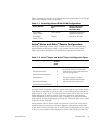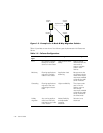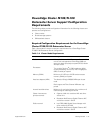
support.dell.com Getting Started 1-7
Figure 1-2. N+1 Failover
Table 1-3 provides a N+1 failover configuration for the cluster shown in Figure 1-2. For
each cluster resource group, the failover order in the Preferred Owners list provides
the order that you want that resource group to failover. If that resource group or its
cluster node fails, the cluster will try to fail that resource group to the first available
node in the list. In this example, node 1 owns cluster resource group A, node 2 owns
cluster resource group B, and node 3 owns cluster resource group C. Cluster
resource groups A, B, or C would failover to cluster node 4, if cluster node 1, 2, or 3
fails, respectively.
NOTE: When implementing this type of failover solution, failback should be config-
ured if the cluster node lacks the resources (such as memory or processing power) to
support one or more cluster node failures.
Multiway Failover
Multiway failover is an active
n
/active failover solution where running applications from
a failed node migrate to multiple nodes in the cluster. This active
n
/active type of
failover provides the following features:
Advantage:
• Automatic failover and load-balancing between the cluster nodes.
Table 1-3. N+1 Failover Configuration for a 4-Node Cluster
Cluster Resource Group Failover Order in the Preferred
Owners List
A1, 4
B2, 4
C3, 4
cluster
node 1
cluster
node 2
cluster
node 3
cluster
node 4
(backup)


















